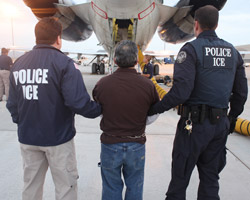Finding Oscar: Massacre, Memory And Justice In Guatemala, Chapter 5
 (Editor’s note: This is the fifth of an eight part series)
(Editor’s note: This is the fifth of an eight part series)
By Sebastian Rotella, ProPublica, and Ana Arana, Fundación MEPI
Chapter 5: The Hunt Moves North
Frustrated that the Dos Erres case had ended up in limbo, Guatemalan activists sued their own government in international court.
The legal action resulted in public disclosure of the list of suspects. A few had died, but the rest were at large. And then help came from an unexpected quarter: a special unit of U.S. Immigration and Customs Enforcement in Washington that tracks down war criminals.
The unit forwarded a lead to Jon Longo, an ICE agent in West Palm Beach, Fla. A compact Italian-American from Boston with a goatee, Longo, 39, had only two years on the job. But he had experience persuading criminals to talk. He held a master’s degree in psychology and had worked for eight years as a prison therapist.
Analysts at ICE headquarters suspected that one of the Kaibil commandos on the Dos Erres list, Gilberto Jordán, was living in Delray Beach, about a half-hour drive from Longo’s office. Jordán worked as a cook at two country clubs. Longo’s orders were to determine if he had taken part in the massacre and, if so, to build a case under U.S. law.
It wasn’t going to be a murder case. Because Jordán had become a U.S. citizen, he could not be deported to Guatemala for trial. Nor could he be prosecuted in U.S. courts for a crime committed many years earlier in a foreign country.
Longo focused instead on U.S. immigration statutes. Jordán, who was 53, had stated on naturalization forms that he hadn’t served in the military or committed crimes in Guatemala. If he had been in the army or participated in the Dos Erres attack, his statements would violate laws against lying to obtain citizenship. Longo wanted to approach the case as simply as possible. He asked himself: “How do I prove these crimes?”
The agent immersed himself in the case file, circling his target. Jordán had left Guatemala soon after the massacre and crossed into Arizona illegally. Thanks to the 1986 immigration amnesty, he became a legal resident. He obtained U.S. citizenship in 1999. He had three grown children — one of them a U.S. Marine and Iraq vet.
Longo obtained Jordán’s army file from the Guatemalan government and confirmed he had been a commando. Separately, agents in Houston caught another Dos Erres suspect: Alonzo, the squad’s baker, who had taken 5-year-old Ramiro. Alonzo had been deported once before. ICE charged him with breaking U.S. laws against re-entering the United States.
In early 2010, Agent Longo interviewed Alonzo about Dos Erres. He also questioned the repentant soldiers-turned-witnesses, Pinzón and Ibañez, who described Jordán’s actions during the massacre. By May, Longo was ready to arrest Jordán. But U.S. prosecutors told Longo he needed more proof that Jordán had participated in the massacre and lied about it. Without direct evidence, such as a confession, they would not indict.
Longo and his bosses decided to knock on Jordán’s door. It was a long shot. Murderers tend to confess more readily on television than in real-life. Especially veteran commandos versed in stealth and psychological warfare.
Longo planned carefully for the confrontation. He was dealing with a highly trained soldier who might own weapons. To help build rapport, Longo enlisted a Latino agent — a military special operations veteran — to approach Jordán with him.
As permitted by law, the ICE team concocted a ruse. Because Jordán had served in the presidential guard, they would tell him they were interested in the recent U.S. arrest of a former Guatemalan president accused of corruption. Then they would ask about Dos Erres. If Jordán refused to talk, they would have to walk away.
On the morning of the operation, Longo deployed agents to tail Jordán’s wife as she worked cleaning homes in the area. The agents planned to confront Jordán at work, but he called in sick. Wearing raid jackets, the agents went to his home in a modest, multiethnic subdivision with narrow streets. Jordán’s truck was parked in the driveway of his well-kept, one-story house, which sits behind a row of tropical trees. The garage door was open when the agents cruised by, but closed when they came back.
Longo called Jordán on his cell phone and identified himself. Jordán politely told him to come over. When the team knocked on his door, though, no one answered. Longo called again. No response. Minutes ticked by. The agents had their hands on their guns.
“We don’t have a warrant,” Longo thought. “He could be getting a cannon ready in there, for all we know.”
Longo directed the agents shadowing Jordán’s wife to stop her and explain the situation. She agreed to call her husband. He reacted like a hunted man.
“They are here to kill me,” Jordán told his wife.
“No, they are the Americans,” she said.
“They have guns,” he replied.
The tension subsided, and Jordán invited the agents into his home. He was short and stolid, with close-cropped gray hair and a lined face. He wore puttering-around clothes: baseball cap, T-shirt, jeans. They sat at a rustic wood kitchen table, photos of Jordán’s children on the walls, and made small talk in Spanish and English. Soon his wife joined them.
Jordán agreed to answer questions, signing a Miranda form after Longo read him his rights. He admitted he had been a commando. He said he did not display military memorabilia in his house because his wife had heard of former soldiers attacked by Guatemalans with grudges against the military.
Longo had dealt with plenty of murderers in his career. Jordán didn’t have the look of a killer. Although calm and guarded, he seemed somewhat eager to talk. He’s throwing out breadcrumbs, Longo thought.
“I had problems in Guatemala,” Jordán said. “They say I did things. There was a massacre.”
“Where?” Longo asked.
“At a place called Dos Erres.”
Longo bided his time. The conversation eventually returned to the massacre. Jordán took a deep breath. He told the story of Dos Erres. He described the slaughter at the well.
“Todos (everyone),” Jordán said, making a gesture to depict victims falling into the well. He began to cry. He said: “I threw a baby into the well.”
Jordán told the agents that he had wept as he killed the infant. He denied raping anyone. His wife listened morosely. She knew all about Dos Erres, Jordán explained.
“I knew this day would come,” Jordán said. He looked relieved. Longo felt Jordán had been dying to get it off his chest.
After about 45 minutes, Longo thanked Jordán for his candor. Heart pounding, he went out to the driveway and called a federal prosecutor to report Jordán’s admissions. The prosecutor knew Longo wanted to handcuff Jordán on the spot. She told him to hold off, saying she wanted to create a clear record that the confession was voluntary.
Tell him to come to your office tomorrow morning for a formal appointment, she said.
The next day, agents arrested Jordán when he showed up with a lawyer. Within weeks, he had agreed to plead guilty to concealing facts and willful misrepresentation on his immigration application.
Prosecutors pushed for the maximum sentence. At a hearing in a Florida courtroom, they called Ramiro Cristales, who had traveled from Canada, where he lived as a refugee. Longo expected Ramiro to be a shell of a man. Instead, the 33-year-old Guatemalan impressed the agent with his courage and maturity.
In his testimony, Ramiro described commandos storming into the house where he lived with his parents and six siblings, and beating and terrorizing the family.
“We started praying because they was saying [to] us, if you believe in God, pray, because nobody will save you,” Ramiro testified.
Though it is not clear how precise his memories are, Ramiro told the court he spent most of the massacre in the church with the women and children. He said the soldiers threw his younger siblings in the well.
 Pedro Pimentel Rios is transferred to a plane bound for Guatemala by U.S. Immigration and Customs Enforcement officials at Phoenix Mesa Gateway airport in Arizona on July 12, 2011. (U.S. Immigration and Customs Enforcement)
Pedro Pimentel Rios is transferred to a plane bound for Guatemala by U.S. Immigration and Customs Enforcement officials at Phoenix Mesa Gateway airport in Arizona on July 12, 2011. (U.S. Immigration and Customs Enforcement)
Jordán’s immigration crime rarely results in a prison term of more than six months. But U.S. District Judge William J. Zloch was disgusted by what he heard in court. He grew even angrier when Jordán’s lawyer argued that her client was not a danger to the community.
“After these allegations?” Judge Zloch demanded. “How many more does he have to commit after this incident? How many more heads have to be smashed in? How many more women need to be raped? How many more people shot? How many?”
In September 2010, the judge sentenced Jordán to the maximum possible term: 10 years in federal prison.
Across the United States, ICE investigators sifted the list of suspects for leads. Agents in Orange County, Calif., arrested Pimentel, the commando who had left for the U.S. military academy in Panama weeks after killing and raping at Dos Erres. In 1985, the U.S. military had awarded Pimentel an Army Commendation Medal for his service. He was found living illegally as a maintenance worker in the United States. Authorities deported him to Guatemala to stand trial.
Federal investigators learned that Sosa, the sub-lieutenant who had allegedly thrown a grenade into the well in Dos Erres, was a U.S. citizen and prominent martial arts instructor in Orange County. Sosa moved to Canada, where he was jailed pending extradition for trial in California on charges of falsifying his U.S. immigration application. Alonzo, Ramiro’s abductor, pleaded guilty in Houston. He agreed to testify against Sosa, his former superior officer.
How We Reported Oscar’s Story:
See source notes for Chapter 5.
This article first appeared in ProPublica.
With reporting fromHabiba Nosheen, Special to ProPublica, and Brian Reed, This American Life
[Photo by ugaldew ]Read Chapter 1 HERE.
Read Chapter 2 HERE.
Read Chapter 3 HERE.
Read Chapter 4 HERE.
E-book
 “Finding Oscar” is available as an e-book with a preface by Sebastian Rotella and exclusive afterword by author Francisco Goldman.
“Finding Oscar” is available as an e-book with a preface by Sebastian Rotella and exclusive afterword by author Francisco Goldman.
Our Partners
 This story was co-reported with This American Life from WBEZ Chicago, which produced a one-hour radio versionairing this weekend on these stations and available for download at 8 p.m. EST Sunday.
This story was co-reported with This American Life from WBEZ Chicago, which produced a one-hour radio versionairing this weekend on these stations and available for download at 8 p.m. EST Sunday.
 Also co-reporting was Fundación MEPI in Mexico City, which published the story in Spanish.
Also co-reporting was Fundación MEPI in Mexico City, which published the story in Spanish.
The Faces of Dos Erres
by Sebastian Rotella and Krista Kjellman Schmidt, ProPublica, May 25
Slideshow
 Oscar’s Story
Oscar’s Story
by Sebastian Rotella and Krista Kjellman Schmidt, ProPublica, May 25
The Dos Erres Massacre and the Hunt for Oscar
by Krista Kjellman Schmidt and Sebastian Rotella, ProPublica, May 25


